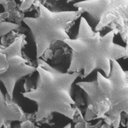Candidate Enzymes for Saffron Crocin Biosynthesis Are Localized in Multiple Cellular Compartments.
الكلمات الدالة
نبذة مختصرة
Saffron is the dried stigmas of Crocus sativus and is the most expensive spice in the world. Its red color is due to crocins, which are apocarotenoid glycosides that accumulate in the vacuole to a level up to 10% of the stigma dry weight. Previously, we characterized the first dedicated enzyme in the crocin biosynthetic pathway, carotenoid cleavage dioxygenase2 (CsCCD2), which cleaves zeaxanthin to yield crocetin dialdehyde. In this work, we identified six putative aldehyde dehydrogenase (ALDH) genes expressed in C. sativus stigmas. Heterologous expression in Escherichia coli showed that only one of corresponding proteins (CsALDH3I1) was able to convert crocetin dialdehyde into the crocin precursor crocetin. CsALDH3I1 carries a carboxyl-terminal hydrophobic domain, similar to that of the Neurospora crassa membrane-associated apocarotenoid dehydrogenase YLO-1. We also characterized the UDP-glycosyltransferase CsUGT74AD1, which converts crocetin to crocins 1 and 2'. In vitro assays revealed high specificity of CsALDH3I1 for crocetin dialdehyde and long-chain apocarotenals and of CsUGT74AD1 for crocetin. Following extract fractionation, CsCCD2, CsALDH3I1, and CsUGT74AD1 were found in the insoluble fraction, suggesting their association with membranes or large insoluble complexes. Analysis of protein localization in both C. sativus stigmas and following transgene expression in Nicotiana benthamiana leaves revealed that CsCCD2, CsALDH3I, and CsUGT74AD1 were localized to the plastids, the endoplasmic reticulum, and the cytoplasm, respectively, in association with cytoskeleton-like structures. Based on these findings and current literature, we propose that the endoplasmic reticulum and cytoplasm function as transit centers for metabolites whose biosynthesis starts in the plastid and are accumulated in the vacuole.



